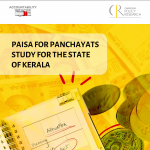
Do regular citizen-led efforts to demand accountability from government result in systemic changes in service delivery?
7 February 2012
Do repeated, regular social audits make a difference? Put a different way, do regular citizen-led efforts to demand accountability from government result in systemic changes in service delivery? Three Accountability Initiative researchers, landed in Hyderabad last night in pursuit of answers to this fundamental, yet complex research question. We hope to find our answers through a qualitiative research study where we will interview participants of social audits along with government officials to gather their perspectives on the effectiveness of successive social audits in Andhra Pradesh.
For the uninitiated, social audits, first evolved by the Mazdooor Kisan Shakti Sangathan (MKSS), are a process by which citizens review and monitor government actions on the ground, and use findings from these reviews to demand accountability from government through the mechanism of a public hearing or Jansunwai. At the hearings, aggrieved citizens place their testimonies in the public domain and government officials are invited to respond to these testimonies and answer questions. The MKSS first experimented with social audits in the mid 1990’s.
In 2005, the Indian Parliament passed the National Rural employment Guarantee Act, now renamed the Mahatma Gandhi National Rural Employment Guarantee Act (MGNREGA), amidst widespread concerns about corruption. Social audits were introduced within the Act as a key mechanism through which corruption would be monitored and checked. According to the Act, social audits must be conducted every six months by the Gram Sabha. Unsurprisingly, there is a vast gap between the law and reality and most parts of the country are yet to implement these audits with one exception, the state of Andhra Pradesh. Consequence of a unique political environment and a rural development (RD) secretary who was keen to find innovative solutions to problems of corruption, Andhra Pradesh took the social audit provision seriously and actually set up an institutional mechanism to carry out social audits. The state now has a social audit society called the Society for Social Audits Accountability and Transparency under the RD department. Since 2006, when the NREGA was launched in the state, as many as 1,736 social audits have been conducted across the state.
Just about the time that the social audits were being initiated, I joined a team of researchers to try and understand the effects of the audits. Since those were early days, we primarily focused on the effects of the audits on people’s awareness about their rights and entitlements under the NREGA. We undertook a 6 month study where we visited over 800 NREGA beneficiaries 3 times over an 8 month period. – once before the social audit, then one month after the audit and finally 6 months after the audit. The findings were unanimous: the audits made a significant difference to raising awareness levels. We also found a few (albeit statistically less significant than the awareness data) improvements in the implementation of the MGNREGA related particularly to wage payments. Crucially, we found that the social audit had some effect on building people’s confidence to question the government and approach officials to resolve their problems. (If you are interested, details of the study can be found on the following link.
Although the study was completed in 2007-08, I had caught the social audit bug. However, as fascinated as I was with this effort at mobilizing citizens (some of the Andhra audits are attended in 1,000’s), I was always left wondering what happens after? Once the noise has died down, does an audit of this nature create enough disincentives to prevent malpractice? From a citizens perspective, once you’ve spoken at an audit and placed your testimony, does government respond and if so, does this ensure that citizens get their rights? In other words, do audits lead to systemic improvements in service delivery and perhaps most important, does this help reduce corruption? These questions have become even more critical in recent years as social audits have now entered the government nomenclature as the appropriate solution to all corruption problems. Having written a few papers on the subject, I find myself being invited on an almost regular basis to government meetings of different departments to talk to them about doing social audits for their various schemes. Of course no one has given any thought to whether the social audit is the appropriate tool or not, it’s now become the accepted solution!
And so, I made my way back to AP in March last year to try and get answers to my question. A lot has changed between 2007 and 2011. The audits have become institutionalized (and almost bureacratized) and to ensure follow up action the RD department has even set up an extensive grievance redressal system. Impressive to say the least! But on looking closely at the data, new questions emerged. My colleagues Sowmya Kapoor and Salimah Samji and I explored social audit data for 3 rounds of audits across 13 districts in the state to find that despite regular audits there has been little change in the nature of complaints (i.e. the nature of corruption) and the officials implicated through the social audits. The same type of official (invariably the field assistant who is responsible for managing the worksite, the branch post master who handles wage payments and the technical assistant or engineer who sanctions works and measures the sites) seem to be indulging in malpractice and inefficiencies, undeterred by social audits. To me, this suggests that there is something specific to the incentive structure of these official posts that encourages such activities, something that social audits have not been able to resolve (for details see this following paper).
And so we asked the obvious question – is this because of ineffective grievance redressal? Or is this a consequence of the very structure of the state at the local level?
To explore these questions, we are now in Hyderabad. The plan is to undertake a detailed qualitative analysis in 10 villages spread across 2 Mandals (blocks) in Medak district (we chose Medak because we have already done significant field work here). In each of these villages, we will identify (through the social audit reports) beneficiaries who complained or expressed a grievance during the social audit and follow what happened after. We will also interview a sample of local officials – those in decision making positions and those who have been implicated in the audits (these would include officials who have been fired or asked to pay money back to beneficiaries in the event of being caught red handed).
My own hunch is that we will find that while social audits are a critical space for strengthening democratic action and creating the relevant pressure points for change, their effectiveness is constrained by structural failures within the state. It is these structural failures that make it difficult for the system ro resovle complaints that emerge from social audits and create disincentives for malpractice. Effective administrative reform is essential and the key ingredient that needs to be mixed in with social audits if we want to see change. Will our field work bare this out? Watch this space for further updates.





